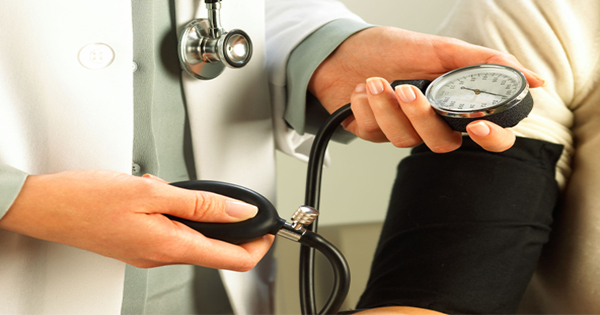What is a Normal Blood Pressure by Age?
 High blood pressure, or hypertension, does not always present with symptoms. You may have high blood pressure and feel perfectly fine. That is why it is important to regularly monitor your blood pressure to ensure you are within normal levels.
High blood pressure, or hypertension, does not always present with symptoms. You may have high blood pressure and feel perfectly fine. That is why it is important to regularly monitor your blood pressure to ensure you are within normal levels.
Your blood pressure reading includes a top number and bottom number. The top number is your systolic reading. This is the pressure blood exerts against artery walls when the heart contracts or beats. The bottom number is the diastolic reading. This measures the force against your artery walls when the heart is relaxed or between beats.
Your blood pressure will fluctuate throughout the day depending on changes in posture, stress, sleep, and exercise. Regardless of fluctuations, your blood pressure on average should remain less than 120/80 mm Hg.
Here are blood pressure categories as defined by the American Heart Association.
Normal blood pressure: <120 / 80 mm Hg
Prehypertension – 120-139 / 80 -89 mm Hg
Stage 1 High Blood Pressure – 140-159 / 90-99 mm Hg
Stage 2 High Blood Pressure – >160 / 100 mm Hg
Hypertensive Crisis – >180 / 110 mm Hg (seek emergency care)
Prehypertension increases your risk for developing high blood pressure. If you have prehypertension, this is an ideal time to assess your diet and lifestyle choices and implement changes to lower levels. Continue reading
How to Reduce Stress When You Don’t Have Time for Activity
 When you are stressed your body releases stress hormones to prepare the body for “fight of flight”. This hormone release causes heart rate to increase and blood vessels to constrict. The combination leads to elevated blood pressure. With short term stress, this is a temporary rise in blood pressure that resolves itself once the stressful situation is resolved.
When you are stressed your body releases stress hormones to prepare the body for “fight of flight”. This hormone release causes heart rate to increase and blood vessels to constrict. The combination leads to elevated blood pressure. With short term stress, this is a temporary rise in blood pressure that resolves itself once the stressful situation is resolved.
But what about when you live with chronic stress?
There is no direct scientific link between chronic stress and high blood pressure. However, stress is connected to many behaviors directly tied to high blood pressure and heart disease, such as consuming alcohol, lack of sleep, and overeating.
Physical activity for stress relief… but what if you don’t have time?
Being physically active is a proven method you can use to reduce stress levels. Activity triggers the brain to release “feel-good” chemicals to ease stress. Exercising and being active are also proven ways to lower blood pressure.
However, time and location may not always be conducive to employ activity to lower stress levels. Here are ten alternate techniques for reducing stress.
- Eat a healthy diet
- Avoid alcohol
Include foods rich in vitamins and minerals to counteract stress, such as fresh vegetables, fresh fruits, fish, and yogurt.
This potential short term “fix” to alleviate stress can quickly turn into a long term problem.
Continue reading
Add Mushrooms to Your Diet to Reduce Heart Disease Risk
 More research is linking vitamin D deficiency as a risk factor for heart disease.
More research is linking vitamin D deficiency as a risk factor for heart disease.
Not truly a vitamin, Vitamin D acts as a hormone that regulates over 200 genes. Some functions of vitamin D include:
- Aids in absorption of calcium within in intestinal track
- Necessary for blood clotting
- Aids in secretion of insulin from the pancreas to regular blood sugar levels
- Stimulates mineralization of bone cells
- Necessary for thyroid function
What causes vitamin D deficiency?
Continue reading
Use Waist-to-Height Ratio to Predict Your Heart Disease Risk
 The waist-to-height ratio is used to measure body fat distribution. A higher ratio is related to increased risk of heart disease due to abdominal obesity.
The waist-to-height ratio is used to measure body fat distribution. A higher ratio is related to increased risk of heart disease due to abdominal obesity.
Waist-to-height ratio and BMI are both popular screening tools for health risks connected to obesity. These methods are quick and cost efficient to use.
Researchers presenting a study with more than 2900 individuals at the 2015 European Congress on Obesity determined waist-to-height ratio measurements to be more accurate and more efficient for identifying heart disease risk when compared to using BMI alone.
When using BMI measurements, 41% of men and 29% of women in the study were classified as “normal”, but had waist-to-height ratios above normal. Researchers determine this would equal 12% of the population being misclassified as normal if only BMI measurements were utilized to assess risk.
Farmers Markets to Lower Blood Pressure with the DASH Diet

This Dietary Approaches to Stop Hypertension (DASH) diet is recommend to manage high blood pressure. This diet is rich in fruits and vegetables. You need to consume between three to five servings of vegetables daily and between four to five fruits daily. That likely sounds overwhelming, but it can be effective in your efforts to lower blood pressure.
One vegetables serving is equal to 1 cup raw leafy green vegetable, ½ cup cut-up raw or cooked vegetables, or ½ cup vegetable juice.
One fruit serving is equal to 1 medium fruit, ¼ cup dried fruit, ½ cup fresh, frozen, or canned fruit, or ½ cup 100% fruit juice.
It’s the perfect time of year to adopt the DASH diet if you are struggling with high blood pressure. Many varieties of produce are in season and farmers markets are readily available.
3 Benefits of Shopping at Farmers Markets
- Farmers markets are environmentally friendly. The food is produced and sold locally, while food in grocery stores travels an average of 1500 miles before it reaches your plate.
- Produce grown for farmers markets is typically allowed to fully ripen naturally before it is harvested. Nothing is used to speed up the ripening process.
- The produce purchased at a farmers market comes straight from the garden. No processing. This equals fresh and nutrient rich food.
Tips for Shopping at Farmers Markets
Shopping at a farmers market is not the same as going to the grocery store.
Continue reading
Delay Onset of High Cholesterol by Maintaining Fitness
 According to a study published in the Journal of the American College of Cardiology, being regularly active delayed age-related cholesterol increases in men by up to 15-years.
According to a study published in the Journal of the American College of Cardiology, being regularly active delayed age-related cholesterol increases in men by up to 15-years.
Research indicates high cholesterol is a risk factor for heart disease. Regular physical activity can reduce this risk. Being physically fit reduces arterial build-up by lowering LDL cholesterol levels while increasing HDL cholesterol. It also lowers other risk factors for atherosclerosis and blood clots, such as diabetes, obesity, high blood pressure, and stress.



